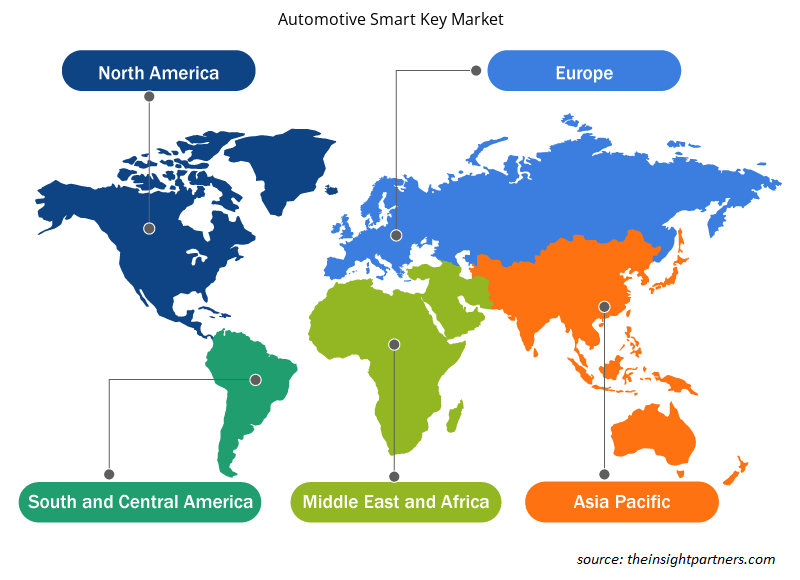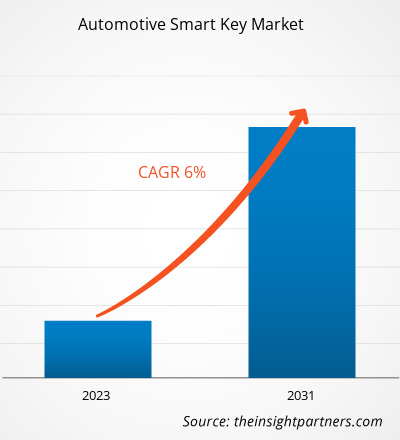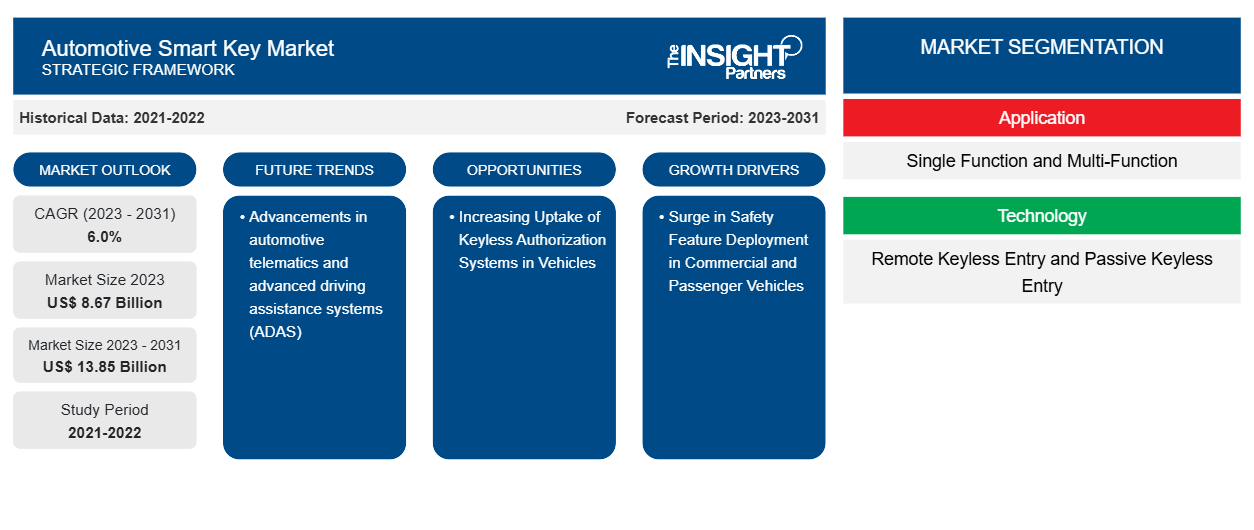Se prevé que el tamaño del mercado de llaves inteligentes para automóviles alcance los 13.850 millones de dólares en 2031, frente a los 8.670 millones de dólares en 2023. Se espera que el mercado registre una CAGR del 6,0 % durante el período 2023-2031. Es probable que los avances en telemática automotriz y sistemas avanzados de asistencia a la conducción (ADAS) sigan siendo tendencias clave en el mercado.
Análisis del mercado de llaves inteligentes para automóviles
Se espera que el aumento de la producción mundial de automóviles de lujo en todo el mundo impulse el crecimiento del mercado de llaves inteligentes para automóviles durante el período de pronóstico. Además, se prevé que el aumento en la implementación de funciones de seguridad en vehículos comerciales y de pasajeros impulse la demanda de llaves inteligentes para automóviles, lo que a su vez se espera que impulse el crecimiento del mercado durante el período analizado. Además, se espera que el aumento en la adopción de sistemas de autorización sin llave en los vehículos cree oportunidades para las empresas que operan en el mercado de llaves inteligentes para automóviles.
Descripción general del mercado de llaves inteligentes para automóviles
La infraestructura del mercado de llaves inteligentes para automóviles comprende principalmente proveedores de hardware/componentes, fabricantes de llaves inteligentes, integradores de sistemas y usuarios finales. Una llave inteligente para automóvil combina varios componentes de hardware, como sensores, microprocesadores , llaves de metal y cajas de cubierta, entre otros. Los principales actores ocupan lugares significativos en los diversos nodos del ecosistema del mercado de llaves inteligentes para automóviles. El hardware de la llave inteligente para automóviles comprende microcontroladores, módulos de radiofrecuencia, fuente de alimentación, transmisores, módulos de control de puertas y paneles de interruptores, entre otros. Los proveedores de componentes suministran el material para construir el hardware de la llave inteligente para automóviles. Luego, los fabricantes de llaves inteligentes llevan a cabo varios procesos, como el diseño, el ensamblaje y la producción, para transformar las materias primas en productos terminados. Los integradores de sistemas reúnen los subsistemas de componentes, lo que garantiza que funcionen de manera eficiente.
Personalice este informe según sus necesidades
Obtendrá personalización en cualquier informe, sin cargo, incluidas partes de este informe o análisis a nivel de país, paquete de datos de Excel, así como también grandes ofertas y descuentos para empresas emergentes y universidades.
-
Obtenga las principales tendencias clave del mercado de este informe.Esta muestra GRATUITA incluirá análisis de datos, desde tendencias del mercado hasta estimaciones y pronósticos.
Factores impulsores y oportunidades del mercado de llaves inteligentes para automóviles
El aumento de la integración de funciones de seguridad en vehículos comerciales y de pasajeros favorece al mercado
La creciente demanda de la incorporación de funciones de seguridad en los vehículos modernos está impulsando el mercado de llaves inteligentes para automóviles en general. La creciente prevalencia del robo de vehículos ha aumentado la demanda de sistemas mejorados con un código único para desbloquear el automóvil, que implica el reconocimiento de un llavero electrónico a través de una autorización de código. Como resultado, los fabricantes de automóviles comenzaron a utilizar microchips encriptados por computadora en su sistema sin llave para mejorar las capas de seguridad que impulsan el crecimiento del mercado. El aumento de los vehículos híbridos y eléctricos, equipados con funciones de seguridad y protección tecnológicamente avanzadas, también ha aumentado la demanda de llaves inteligentes. Por ejemplo, Keyless Go de Mercedes permite al conductor bloquear y desbloquear un vehículo sin usar los botones de la llave inteligente correspondiente. Cuando el conductor ingresa a un automóvil con una tarjeta Keyless Go SmartKey equipada, puede encender y apagar el motor sin insertar la llave inteligente. Se espera que los avances tecnológicos, como la transmisión y los sensores infrarrojos, fortalezcan las funciones de seguridad y se espera que impulsen considerablemente el crecimiento del mercado durante el período de pronóstico.
Aumento de la adopción de sistemas de autorización sin llave en los vehículos
La demanda de sistemas de entrada sin llave activos y pasivos para bloquear, desbloquear y arrancar el motor del automóvil de forma remota mediante señales de radiofrecuencia ha aumentado significativamente. Las llaves mecánicas restringen el acceso no autorizado a los automóviles. Los vehículos modernos utilizan microcontroladores para aplicaciones como sistemas de entrada sin llave pasivos y sistemas inmovilizadores de vehículos. Los sistemas electrónicos integrados son convenientes; sin embargo, la seguridad del sistema puede ser violada por robo o falla en el escaneo de la interfaz inalámbrica. Este factor ha llevado al desarrollo de un sistema de entrada sin llave para automóviles que utiliza autenticación de dos factores, en el que el automóvil puede verificar de forma autónoma el marco de autenticación del llavero basado en el usuario y el dispositivo, lo que permite un sistema de autenticación de dos factores. Las tendencias emergentes de autenticación de dos factores en sistemas de autorización sin llave para evitar violaciones de seguridad y piratería están impulsando el mercado mundial de llaves inteligentes para automóviles. Una tecnología de radio de última generación, un sistema innovador sin llave, un sistema de ubicación de llaves de alta precisión y sin interferencias brindan seguridad y comodidad óptimas a los conductores y pasajeros.
Análisis de segmentación del informe de mercado de llaves inteligentes para automóviles
Los segmentos clave que contribuyeron a la derivación del análisis del mercado de llaves inteligentes automotrices son la aplicación y la tecnología.
- Según la aplicación, el mercado de llaves inteligentes para automóviles se divide en función única y función múltiple. El segmento de función única tuvo la mayor participación de mercado en 2023.
- Por tecnología, el mercado está segmentado en entrada remota sin llave y entrada pasiva sin llave. El segmento de entrada remota sin llave tuvo la mayor participación del mercado en 2023.
Análisis de la cuota de mercado de llaves inteligentes para automóviles por geografía
El alcance geográfico del informe del mercado de llaves inteligentes automotrices se divide principalmente en cinco regiones: América del Norte, Asia Pacífico, Europa, Medio Oriente y África, y América del Sur.
El alcance del informe del mercado de llaves inteligentes para automóviles abarca América del Norte (EE. UU., Canadá y México), Europa (Alemania, Francia, Italia, España, Reino Unido y resto de Europa), Asia Pacífico (China, India, Australia, Japón, Corea del Sur y resto de Asia Pacífico), Oriente Medio y África (Sudáfrica, Arabia Saudita, Emiratos Árabes Unidos y resto de Oriente Medio y África) y América del Sur (Brasil, Argentina y resto de América del Sur). En términos de ingresos, Asia Pacífico dominó la cuota de mercado de llaves inteligentes para automóviles en 2023. Europa fue el segundo mayor contribuyente de ingresos al mercado mundial de llaves inteligentes para automóviles, seguida de América del Norte.
Perspectivas regionales del mercado de llaves inteligentes para automóviles
Los analistas de Insight Partners explicaron en detalle las tendencias y los factores regionales que influyen en el mercado de llaves inteligentes para automóviles durante el período de pronóstico. Esta sección también analiza los segmentos y la geografía del mercado de llaves inteligentes para automóviles en América del Norte, Europa, Asia Pacífico, Oriente Medio y África, y América del Sur y Central.

- Obtenga datos regionales específicos para el mercado de llaves inteligentes para automóviles
Alcance del informe de mercado de llaves inteligentes para automóviles
| Atributo del informe | Detalles |
|---|---|
| Tamaño del mercado en 2023 | US$ 8,67 mil millones |
| Tamaño del mercado en 2031 | US$ 13.85 mil millones |
| CAGR global (2023 - 2031) | 6.0% |
| Datos históricos | 2021-2022 |
| Período de pronóstico | 2023-2031 |
| Segmentos cubiertos |
Por aplicación
|
| Regiones y países cubiertos |
América del norte
|
| Líderes del mercado y perfiles de empresas clave |
|
Densidad de actores del mercado de llaves inteligentes para automóviles: comprensión de su impacto en la dinámica empresarial
El mercado de llaves inteligentes para automóviles está creciendo rápidamente, impulsado por la creciente demanda de los usuarios finales debido a factores como la evolución de las preferencias de los consumidores, los avances tecnológicos y una mayor conciencia de los beneficios del producto. A medida que aumenta la demanda, las empresas amplían sus ofertas, innovan para satisfacer las necesidades de los consumidores y aprovechan las tendencias emergentes, lo que impulsa aún más el crecimiento del mercado.
La densidad de actores del mercado se refiere a la distribución de las empresas o firmas que operan dentro de un mercado o industria en particular. Indica cuántos competidores (actores del mercado) están presentes en un espacio de mercado determinado en relación con su tamaño o valor total de mercado.
Las principales empresas que operan en el mercado de llaves inteligentes para automóviles son:
- Corporación ALPHA
- Continental AG
- Corporación Denso
- Fabricante de cerraduras Honda, Ltd.
- Silca SpA
- Corporación Toyota Motor
Descargo de responsabilidad : Las empresas enumeradas anteriormente no están clasificadas en ningún orden particular.

- Obtenga una descripción general de los principales actores clave del mercado de llaves inteligentes para automóviles
Noticias y desarrollos recientes del mercado de llaves inteligentes para automóviles
El mercado de llaves inteligentes para automóviles se evalúa mediante la recopilación de datos cualitativos y cuantitativos a partir de una investigación primaria y secundaria, que incluye publicaciones corporativas importantes, datos de asociaciones y bases de datos. A continuación, se enumeran algunos de los avances en el mercado de llaves inteligentes para automóviles:
- HELLA ha presentado una nueva solución de acceso digital a través de la llave del vehículo basada en tecnología de banda ultraancha para fabricantes de automóviles de pasajeros. Este nuevo sistema de acceso inteligente al vehículo ofrece una mayor comodidad a los usuarios, ya que permite acceder al vehículo completamente con manos libres y a través de un teléfono inteligente. (Fuente: HELLA GmbH, comunicado de prensa, junio de 2021)
- Silca SpA lanza Remote Vehicle Key TOY49R25, una nueva referencia para duplicar llaves de coche a distancia compatibles con Citroën, Peugeot y Toyota: la solución ideal para sustituir llaves originales dañadas o perdidas o disponer de un duplicado en caso de emergencia. (Fuente: Silca SpA, Nota de prensa, septiembre de 2021)
Informe sobre el mercado de llaves inteligentes para automóviles: cobertura y resultados
El informe “Tamaño y pronóstico del mercado de llaves inteligentes para automóviles (2021-2031)” proporciona un análisis detallado del mercado que cubre las siguientes áreas:
- Tamaño del mercado de llaves inteligentes para automóviles y pronóstico a nivel mundial, regional y nacional para todos los segmentos clave del mercado cubiertos bajo el alcance
- Tendencias del mercado de claves inteligentes para la automoción, así como dinámicas del mercado, como impulsores, restricciones y oportunidades clave
- Análisis PEST y FODA detallados
- Análisis del mercado de llaves inteligentes para automóviles que abarca las tendencias clave del mercado, el marco global y regional, los principales actores, las regulaciones y los desarrollos recientes del mercado
- Análisis del panorama de la industria y de la competencia que abarca la concentración del mercado, el análisis de mapas de calor, los actores destacados y los desarrollos recientes del mercado de llaves inteligentes para automóviles
- Perfiles detallados de empresas
- Análisis histórico (2 años), año base, pronóstico (7 años) con CAGR
- Análisis PEST y FODA
- Tamaño del mercado, valor/volumen: global, regional y nacional
- Industria y panorama competitivo
- Conjunto de datos de Excel
Informes recientes
Testimonios
Razón para comprar
- Toma de decisiones informada
- Comprensión de la dinámica del mercado
- Análisis competitivo
- Información sobre clientes
- Pronósticos del mercado
- Mitigación de riesgos
- Planificación estratégica
- Justificación de la inversión
- Identificación de mercados emergentes
- Mejora de las estrategias de marketing
- Impulso de la eficiencia operativa
- Alineación con las tendencias regulatorias























 Obtenga una muestra gratuita para - Mercado de llaves inteligentes para automóviles
Obtenga una muestra gratuita para - Mercado de llaves inteligentes para automóviles